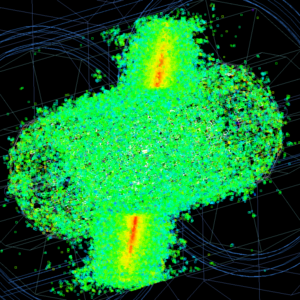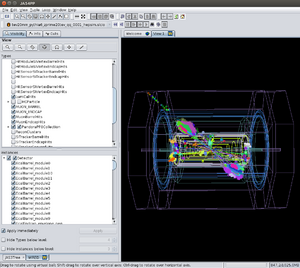Software:Jas4pp
 Example Jas4pp histogram and function | |
| Original author(s) | Dr. Sergei V. Chekanov et al. |
|---|---|
| Initial release | 2016 |
| Stable release | 1.7
/ April 2023 |
| Written in | Java |
| Operating system | Cross-platform, Windows, MacOS, Software:Linux |
| Available in | English |
| License | Open source (GPLv3 or later, GPL and similar) |
| Website | atlaswww |
Jas4pp (Java Analysis Studio for Particle Physics) is a program for data analysis and event visualization [1] [2].
The program is currently supported by ANL. Together with the description of this program, basic tutorials and advanced examples will be described. The core part of Jas4pp is the package called Jas3 (Java Analysis Studio) [3] developed at SLAC. It is an AIDA compliant, flexible platform that can be configured via plugins for different experiments. Being backward compatible with the original Jas3,
Jas4pp focuses on data analysis in collider particle physics. It includes Jython 2.7.4 (compatible with Python 2.7.4),
2D/3D visualization libraries from the DataMelt platform [4], GROOT libraries (JLab), LCIO [5], improved LCSIM, mathematical libraries from the Apache foundation
and a software library [6] for validation of Monte Carlo
events from the HepSim repository [7]. Jas4pp fully supports ProMC [8] and ProIO [9] file formats. Jas4pp uses its own input-output libraries, with limited support for reading ROOT files.
One distinct feature of Jas4pp is that it includes HEP libraries by default instead of downloading additional plugins.
This makes Jas4pp a self-contained program for analysis and event visualization.
The LCSIM library was significantly improved to increase the processing speed of tracking hits when complex events are visualized inside Jas4pp.
Main features
The main features of Jas4pp are: (a) a full stack of data analysis libraries (histogramming, ntuples, non-linear regressions using interactive GUI etc.); (b) 2D / 3D visualization; (c) Physics libraries for vectors with Lorentz transformations, limit setting, event-shape studies and jet reconstruction and other. In particular, the antiKT4 algorithm for analysis of proton-proton (pp) collision events is included. Jas4pp can be used to analyze truth-level events from the HepSim repository (which contains more than 100 scripts executed directly in Jas4pp), as well as to process and visualize events after the Geant4 simulation [10]. Jas4pp runs on any platform with Java installed, including Windows. The time of deployment of Jas4pp is compatible with the time needed to download this package to a local computer.
Codding with Jas4pp
Jas4pp supports Jython, Groovy and Java for analysis code. The Jas4pp has a flexible IDE with full syntax highlighting support.
 The image shows the Jas4pp IDE together with analysis code and the execution result.
The image shows the Jas4pp IDE together with analysis code and the execution result.
Event display features
Similar to Jas3, the event display is implemented using the Wired4 program. The events can be visualized after opening a SLCIO file. During file opening, appropriate detector geometry is downloaded.
A typical collision events of two protons at 100 TeV is illustrated in the image below [11].
 The image shows a hypothetical particle (Z') with the mass 40 TeV decaying to W+ and W- bosons.
The image shows a hypothetical particle (Z') with the mass 40 TeV decaying to W+ and W- bosons.
Such heavy particles can only be produced at the FCC-hh experiment with the center-of-mass of energy of 100 TeV for colliding protons. The transverse momenta of these bosons from the Z' decay is about 20 TeV.
 This image shows a hypothetical particle (Z') with the mass 20 TeV decaying to 2 jets. The image shows the main event display with the detector, topological clusters, and a panel for selection of displayed objects.
This image shows a hypothetical particle (Z') with the mass 20 TeV decaying to 2 jets. The image shows the main event display with the detector, topological clusters, and a panel for selection of displayed objects.
The event display is fully interactive. It shows up 80,000 cells that can be studied after zooming.
Usage
Jas3 was extensively used for the SiD detector concept [12] of the ILC project. Currently, Jas4pp is used in several detector studies, such as CEPC tracking studies [13], FCC-hh [14] [15] [16] [17] calorimeter studies, development of the TOPSiDE detector and physics studies for the EIC future collider [18]. Event visualization of complex events created in proton-proton collisions at 100 teraelectonvolts (TeV) created with the help of Jas4pp were featured on the FCC-mass media portal [19]. Jas4pp was also used for HL-LHC and HE-LHC studies based on HepSim Monte Carlo event samples.
References
- ↑ "JAS4pp. Java Analysis Studio for Particle Physics" () , , Accessed: 2020-05-25 https://atlaswww.hep.anl.gov/asc/jas4pp/
- ↑ S. V. Chekanov, G. Gavalian, N. A. Graf, Jas4pp - a Data-Analysis Framework for Physics and Detector Studies, (2020), (https://arxiv.org/abs/2011.05329) (2020) ANL-HEP-164101, SLAC-PUB-17569
- ↑ "JAS3. Java Analysis Studio" () , , Accessed: 2020-05-25 http://jas.freehep.org/jas3/
- ↑ Chekanov, S.V. "Numeric Computation and Statistical Data Analysis on the Java Platform" (Book) (Book), Springer (2016) 620 ISBN ISBN 978-3-319-28531-3 https://datamelt.org
- ↑ Gaede, FrankBehnke, TiesGraf, Norman AnthonyJohnson, Tony "LCIO - A persistency framework for linear collider simulation studies" , (2003) , p. arXiv: https://arxiv.org/abs/0306114
- ↑ Chekanov, S.V.Pogrebnyak, I.Wilbern, D. "Cross-platform validation and analysis environment for particle physics" Comput. Phys. Commun. (2017) 220, p.91--96 arXiv: https://arxiv.org/abs/1510.06638
- ↑ Chekanov, S.V. "HepSim: a repository with predictions for high-energy physics experiments" Advances in High Energy Physics (2015) 2015, p.136093 Available as \url{http://atlaswww.hep.anl.gov/hepsim/}
- ↑ Chekanov, S.V.Strand, K.Van Gemmeren, P.May, E. "ProMC: Input-output data format for HEP applications using varint encoding" Comput. Phys. Commun. (2014) 185, p.2629--2635 arXiv: https://arxiv.org/abs/1311.1229
- ↑ Blyth, DavidAlcaraz, Jose de JesusBinet, SChekanov, S. V. "ProIO: An Event-Based I/O Stream Format for Protobuf Messages" Computer Physics Communications (2019) 241, p.
- ↑ Allison, J.others "Recent developments in Geant4" Nuclear Instruments and Methods in Physics Research A (2016) 835, p.186
- ↑ FCC news, May 31, 2016 https://fcc.web.cern.ch/Pages/news/Complex-detector-simulations-of-proton-collisions-for-FCC-.aspx
- ↑ Abramowicz, Halinaothers "The International Linear Collider Technical Design Report - Volume 4: Detectors" , (2013) , p. arXiv: https://arxiv.org/abs/1306.6329
- ↑ Dong, Mingyiothers "CEPC Conceptual Design Report: Volume 2 - Physics \& Detector" (2018) , p. arXiv: https://arxiv.org/abs/1811.10545
- ↑ Chekanov, S. V.Beydler, M.Kotwal, A. V.Gray, L.Sen, S. etc. "Initial performance studies of a general-purpose detector for multi-TeV physics at a 100 TeV pp collider" JINST (2017) 12, 06 p.P06009 arXiv: https://arxiv.org/abs/1612.07291
- ↑ Yeh, C.H.Chekanov, S.V.Kotwal, A.V.Proudfoot, J.Sen, S. etc. "Jet Substructure Variables with the SiFCC Detector at 100 TeV" PoS (2019) ICHEP2018, p.905 arXiv: https://arxiv.org/abs/1811.12805
- ↑ Yeh, C.-H.Chekanov, S.V.Kotwal, A.V.Proudfoot, J.Sen, S. etc. "Studies of granularity of a hadronic calorimeter for tens-of-TeV jets at a 100 TeV $pp$ collider" JINST (2019) 14, 05 p.P05008 arXiv: https://arxiv.org/abs/1901.11146
- ↑ Chekanov, S.V.Kotwal, A.V.Yeh, C.-H.Yu, S.-S. "Physics potential of timing layers in future collider detectors" (2020) , p. , ANL-HEP-159872, contribution to Snowmass 2021 arXiv: https://arxiv.org/abs/2005.05221
- ↑ Repond, Jose "TOPSiDE: Concept of an EIC Detector" PoS (2018) DIS2018, p.179 {XXVI International Workshop on Deep-Inelastic Scattering and Related Subjects (DIS2018) 16-20 April 2018 Kobe University, Kobe, Japan}
- ↑ FCC news, May 31, 2016 https://fcc.web.cern.ch/Pages/news/Complex-detector-simulations-of-proton-collisions-for-FCC-.aspx
External links
